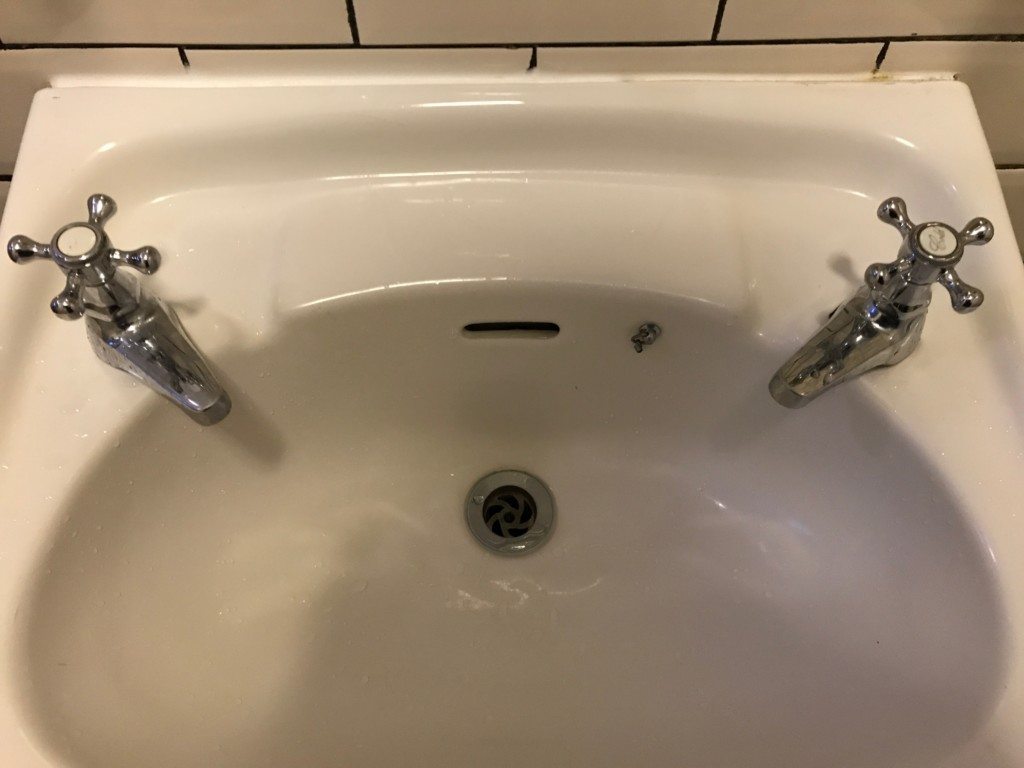As I write this article, I’m sipping tea in Dublin, Ireland, thinking about Irish bathroom faucets. Specifically, I’m pondering their striking similarity to the Electoral College, the inch-pound system, space shuttle engines, and car headlights.
More on that jumble of thoughts in a minute.
We’re wrapping up a magnificent trip to Ireland. We fell in love with the country’s natural landscapes; the stone houses that dot the rivers that flow through its cities; its delicious scones (crisp on the outside, soft on the inside); its warm, hospitable people; and, of course, its pubs.
So why am I stuck on the faucets? Well, many faucets in Ireland look like this:

As you stand in the bathroom ready to wash your hands, you face a daunting choice between ice cold water and scalding hot water coming out of the opposite ends of the sink. The plumbing system omits a simple modern technology: a pipe that connects the cold and hot water pipes, the combination of which produces a spectacular something that I had been taking for granted all of my life: warm water.
The faucets in Ireland are an excellent example of a behavioral phenomenon I spend a lot of time thinking about: the status quo bias. People tend to be biased against “the way things could be” and find comfort in “the way that things are.”
If you had any doubts about society’s obsession with the status quo, take a look at all these idioms dedicated to avoiding change. “If it ain’t broke, don’t fix it.” “Don’t rock the boat.” “Don’t change horses in the middle of the stream.” “Go with the devil you know.”
Now, I haven’t done my research on this, but my guess is that someone in Ireland, a very long time ago, decided that it was easier or cheaper to build two faucets on opposite sides of the sink supplied by two separate pipes. The current configuration thus became stuck, largely for a historical lack of someone raising their hand and asking “why don’t we connect these two pipes?!?!”
Sometimes, there are good, rational reasons for retaining the status quo. But often we reject change even when the benefits far exceed the costs.
Consider some of these other examples (some of which you may recognize from my previous articles):
1. It was a Roman road engineer who determined the width of the fuel engines that power the Space Shuttle. The Space Shuttle engines were 4 feet 8.5 inches wide because that was the width of the rail line that would carry the engines from Utah to Florida. The width of that rail line, in turn, was based on the width of tramlines in England, which, in turn, was based on the width of the roads built by the Romans: 4 feet 8.5 inches.
2.The keyboard layout in front of you was designed to be inefficient. Before the current arrangement, typewriters would jam if you typed too quickly. The current QWERTY layout (named after the first six letters on the keyboard) was created specifically to slow down typing speed to prevent mechanical key blockage. In addition, for marketing purposes, the letters that make up the word “TYPEWRITER” were placed on the top line to allow salespersons to demonstrate how the machine operates by quickly typing the brand name.
Of course, mechanical key blockage is no longer a problem. Nor is there a need to type “TYPEWRITER” as quickly as possible. Yet despite the availability of far more efficient and far more ergonomic layouts, the QWERTY arrangement still dominates.
3. Constitutions–my scholarly area of expertise–also tend to stick.
Even in transitions from dictatorship to democracy–when one might expect tectonic constitutional shifts–the resulting constitutional changes are often relatively minor. For example, the recent constitutional makeovers after the Arab Spring produced constitutions that look remarkably similar to their predecessors.
The Electoral College is a good domestic example. A fairly innovative mechanism by the standards of 1789, the Electoral College makes little sense today. Yet, here we are, still counting electors instead of tallying the popular vote.
4. Modern automobiles have two headlights because horse-drawn carriages had two lanterns. You couldn’t put a lantern in the middle because that’s where the horse went. Even in the revolutionary transition to engine-powered transportation, the two headlight system got stuck.
5. I grew up with the metric system, so I might be slightly biased here, but I’ve always thought the inch-pound system is vastly inferior. In 1975, the U.S. Congress apparently thought the same. It enacted the Metric Conversion Act, which established the U.S. Metric Board to “coordinate and plan the increasing use of the metric system in the United States.” Inflicted with the status quo bias, the American public largely ignored the Metric Board’s proposals, and the Board was disbanded in 1982.
What else is still stuck?
Bold


